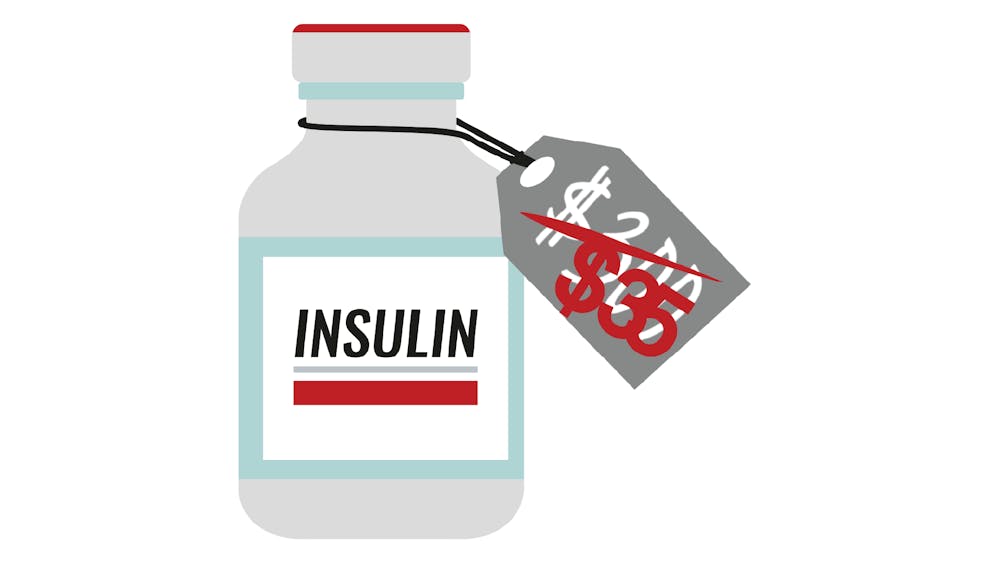I was distributing newspapers on the morning of March 1, 2023, when my earbuds suddenly paused my Taylor Swift playlist to bombard me with a breaking news alert: Eli Lilly, one of the biggest insulin producers in the world, had decided to cap their out-of-pocket prices at $35 a month. I was standing in the middle of Global Commons, holding dozens of papers, when I broke down in tears at the sight of my phone. At that moment, an NBC news alert changed the trajectory of my life and informed me I could now afford to pursue my dreams.

When I was diagnosed with Type 1 diabetes at only two years old, I had no idea what lay ahead, the sacrifices I'd have to make, or how different my life would be from my friends. Over the years, as I became more aware of these things, I also discovered how expensive life with diabetes is — or, should I say, was.
For as long as I can remember, I've wanted to become a doctor. However, once I started doing the math, I realized I might be unable to. On top of the ridiculously high cost of attending medical school in the U.S., I'd also have to pay for all my expenses related to diabetes. This reality only became more apparent as I started racking up additional chronic health issues and their coinciding expenses.
Naturally, when I saw the news that Eli Lilly would cap their out-of-pocket prices at $35 a month, I was at a loss for words. Up until this point, I planned my life around affording my insulin. I planned my life out of necessity, not desire because I didn't think I'd ever have the option to pursue my dream career.
Shortly after Eli Lilly's announcement, Novo Nordisk and Sanofi followed suit, and both agreed to join Lilly in cutting insulin prices by 70%. The price capping will mainly benefit people with high deductibles under private insurance plans.
According to a New York Times article, Eli Lilly, Sanofi and Novo Nordisk control around 90% of the insulin market. These recent communiqués brought waves of relief to diabetics nationwide. However, for many people, these efforts arrived too late.
The current changes won’t erase history. People have faced serious health issues, including amputations, kidney failure, Diabetic Ketoacidosis and more because they couldn't afford insulin. Many people have died as a result of insulin rationing, an all-too-common practice where a diabetic will take less insulin than needed in an effort to extend the use of a vial. In a study published in 2021 by the Annals of Internal Medicine, 18.6% of Type 1 Diabetics reported insulin rationing due to the high costs of the necessary medication. The estimated number of Type 1 and 2 diabetics who rationed insulin was 1.3 million.
On the surface, it may seem like Lilly is at the forefront of a movement to decrease expenses for people with diabetes. However, if you dig deeper, you will see that might not be the case.
According to a New York Times article, over the past three decades, Lilly has raised the sticker price of Humalog, their most commonly-used insulin, by over 1000%.
Politicians and patients alike have been lobbying for years to lower the price of insulin, and only now have pharmaceutical companies listened. Even so, these changes only come on the heels of President Joe Biden’s remarks during his State Of The Union address and last year's Inflation Reduction Act that imposed a reduction bringing out-of-pocket insulin prices to $35 a month for people with Medicare.
Another essential thing to note is not all insulin will have its price capped at $35 a month. The insulin that has been capped is vials of fast-acting insulin, generally given through an insulin pump or combined with long-acting insulins. Unfortunately, long-acting insulins have not had their price reduced, and neither have insulin pumps.
Additionally, Lilly’s newer Humalog product prices have not been reduced at all. The company cited their pre-filled Humalog autoinjectors will still have a sticker price of $530.
While this is the most progress people with diabetes have seen in the fight to afford life, it is vital to recognize that there is still a long way to go. Insulin is far from the only outrageous medical expense diabetics have.
According to the National Library of Medicine, the average annual cost of being a Type 1 diabetic in the U.S. is over $17,000 as of 2016, with insulin costs accounting for just over $6,000.
So though I am forever grateful to Eli Lilly, Sanofi and Novo Nordisk for capping costs, I also want to recognize that we still have a long way to go before our basic survival needs become truly accessible.


